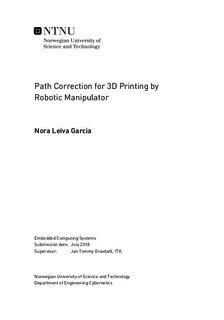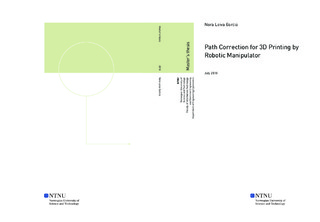| dc.description.abstract | Technology is an essential part of industry nowadays, thanks to which there are advances in quality of the product, efficiency of energy or safety of human capital (among others). Today, we are part of the fourth industrial revolution, where mass production is being replaced by customized production and Additive Manufacturing (group of technologies that build 3D objects by adding material layer-by-layer) and Robotics (an interdisciplinay branch of engineering and science that deals with the design, construction, operation and use of robots) are becoming leading technologies.
The primary objective of this work is to correct the path of a 6 Degrees Of Freedom (DOF) robotic arm with 3D printing purposes. Improving the error detection in real time can make the usage of robotic arms in 3D printing grow noticeably, as a result of making them as efficient and useful in industry as possible (which is the main motivation of this research).
A piece of code will be developed in RAPID (programming language used in ABB robots) in order to correct two important errors that occur while printing. One of the errors comes linked to the use of materials that expand or contract after being deposited (insulation foam for example), as this change in size affect to the final dimensions of the product, and more specifically to the height of each layer printed. The other is the path deviation in straight lines, where an iterative correction (ILC control method) layer-by-layer is needed until the good coordinates are reached.
To test the effectiveness of the code, different experiments will be carried out in Robotstudio (ABB software where code can be tested using a Virtual Controller and a replica of the real robotic station) as well as in the IRB140 (real robot at the laboratory). During the experiments, different data will be obtained and exported to a text file. After that, the information will be reorganized in EXCEL and used in MATLAB to obtain some graphs. At the end, the performance of the code will be evaluated by studying the graphs and comparing the results obtained in Robotstudio with those obtained when using the robot IRB140.
Once the experiments have been done and all the information obtained from them has been analyzed, a discussion will be done on whether the errors have been corrected or not as well as on further work that could be done on this area.
The results show that the errors have been corrected after applying the code developed in this project; and moreover, the influence of the difference variables has been tested to be the one expected, except for one case. | |

